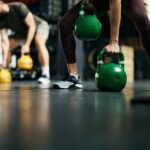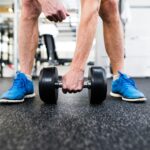Story at-a-Glance
- Vitamin D regulates hormones like leptin, which balances energy, and myostatin, which limits muscle growth, directly impacting energy management, muscle development, and fat storage through metabolic pathways.
- A May 2024 preprint study on Research Square showed high-dose vitamin D boosts muscle strength, lowers myostatin, directs calories to muscle growth, and increases metabolic rate.
- Vitamin D mimics anabolic steroids by suppressing myostatin to enhance muscle growth, redirecting energy from fat to muscle, and elevating metabolic rate, without the associated risks.
- Optimal vitamin D levels for health and disease prevention are 60–80 ng/mL (150–200 nmol/L); test twice yearly and adjust supplementation based on results.
- Sunlight is the best source of vitamin D, offering benefits beyond production, but reduce vegetable oil intake before sun exposure to minimize risks.
For years, energy storage was considered a simple equation: consume more calories than you burn, and the excess becomes fat. However, recent research reveals energy balance is far more complex, driven by hormonal regulation rather than just calorie intake. This system determines whether energy is stored as fat or used for muscle maintenance.
Two key hormones—leptin, which regulates hunger and fat storage, and myostatin, which restricts muscle growth—play central roles. Researchers from The Children’s Hospital of Philadelphia and The University of Pennsylvania Perelman School of Medicine found vitamin D influences both, suggesting it significantly affects energy management and muscle growth. Researcher Georgi Dinkov, inspired by biologist Ray Peat, notes vitamin D’s effects on muscle and fat metabolism resemble anabolic steroids, but without harmful side effects.
How Anabolic Steroids Work and Their Risks
Anabolic steroids, synthetic compounds that enhance muscle growth and reduce fat, alter hormone signaling, particularly via testosterone. Dinkov outlines their mechanisms:
- Suppressing myostatin: Lowers myostatin to enable unrestricted muscle growth.
- Boosting protein synthesis: Enhances nitrogen retention for faster muscle protein production.
- Redirecting calories: Shifts energy toward muscle-building rather than fat storage.
- Increasing metabolic rate: Greater muscle mass raises resting metabolic rate (RMR), burning more calories.
However, steroids carry serious risks:
- Hormonal disruption: Suppresses natural testosterone, causing testicular shrinkage, infertility, and hormone therapy dependence.
- Liver and heart damage: Increases risks of liver toxicity, high blood pressure, cholesterol issues, and heart attacks.
- Psychological effects: Alters dopamine and serotonin, leading to mood swings, aggression, anxiety, depression, and addiction.
Vitamin D offers a safer alternative for muscle growth and fat loss.
Vitamin D’s Role in Muscle Growth and Fat Storage
Known for bone health, vitamin D’s influence extends to energy regulation, as shown in a May 2024 Research Square preprint study. Key findings include:
- Nutrient sensor: Vitamin D signals nutrient availability, guiding energy allocation between fat storage, muscle growth, and metabolism via the vitamin D receptor (VDR).
- Leptin regulation: Vitamin D enhances leptin production and sensitivity, crucial for energy balance. VDR knockout mice lacking vitamin D signaling had low leptin and minimal white fat.
- Muscle function: Vitamin D deficiency causes muscle weakness; supplementation restores strength. Higher doses further improve muscle performance.
- Muscle-fat connection: Muscle and fat mass are interlinked. Muscle gain often increases fat mass, while significant weight loss reduces both. Dinkov emphasizes body repartitioning—gaining muscle to lose fat—over blind weight loss, which depletes muscle.
- Myostatin and leptin regulation: Loss of vitamin D signaling increases myostatin, limiting muscle growth, and lowers leptin, disrupting fat metabolism.
Can Vitamin D Mimic Anabolic Steroids?
The study tested mice with varying vitamin D doses (0, 2,000, and 10,000 IU/kg), revealing:
- Enhanced muscle strength: High-dose vitamin D significantly increased grip strength, mimicking steroids’ protein synthesis effects, independent of diet or exercise.
- Myostatin suppression: Higher vitamin D levels reduced myostatin, promoting muscle growth, with muscle mass increasing even at high doses.
- Calorie redirection: High-dose vitamin D shifted energy to muscle over fat, increasing lean mass without changing total weight, similar to steroids.
- Improved fat metabolism: Higher vitamin D improved leptin signaling, enhancing fat metabolism, akin to steroids’ insulin and cortisol effects.
- Metabolic rate boost: High-dose vitamin D increased energy expenditure without altering food intake or activity, naturally raising RMR like steroids.
- Skeletal growth: High-dose vitamin D increased height in mice and skeletal growth in zebrafish, mirroring steroids’ bone density effects.
These findings confirm vitamin D replicates key steroid benefits without risks.
Sunlight: The Ideal Vitamin D Source
While supplements are effective, sunlight is optimal for vitamin D production, offering additional benefits:
- Beyond vitamin D: UV exposure triggers nitric oxide release, immune modulation, and mitochondrial support, enhancing vitamin D’s effects.
- Seed oils and UV risks: Linoleic acid (LA) in vegetable oils, when exposed to UV, causes inflammation and DNA damage, increasing photoaging and skin cancer risks.
- Dietary caution: High vegetable oil consumers should limit sun exposure to early morning or late afternoon until oils are eliminated (4–6 months).
- Skin pigmentation: Darker skin requires longer exposure for equivalent vitamin D production.
- Body fat risks: Higher body fat stores LA, prolonging oxidative stress post-dietary changes, necessitating cautious sun exposure.
Safe Sun Exposure Guidelines
Use the “sunburn test” to gauge safe exposure—avoid redness to prevent UV damage. Tips include:
- Seed oil clearance: Susceptibility to sunburn decreases as LA stores diminish. Avoid peak UV hours (10 a.m.–4 p.m.) for six months after eliminating oils; full clearance takes ~2 years.
- Seasonal adjustments: Peak hours shift with Daylight Saving Time (solar noon at 1 p.m.).
- Protective measures:
- Take 12 mg astaxanthin daily for UV resistance.
- Apply niacinamide cream to protect against DNA damage.
- Take 81 mg aspirin 30–60 minutes before exposure to prevent harmful LA metabolites.
- Use molecular hydrogen supplements to reduce oxidative stress.
Vitamin D Supplementation Tips
When sunlight is limited, supplementation is key, especially in northern climates or for indoor lifestyles:
- Vitamin D3 over D2: D3, produced naturally via UVB, is more effective at raising blood levels than plant-derived D2.
- Regular testing: Optimal levels are 60–80 ng/mL (150–200 nmol/L), far above the deficiency threshold (20 ng/mL). Test twice yearly to account for seasonal changes.
- Optimization steps:
- Test levels biannually.
- Adjust sun exposure or supplementation based on results.
- Retest after 3–4 months to fine-tune dosage.
- Monitor to maintain optimal range.
- Higher doses for benefits: Standard 2,000 IU/day ensures basic sufficiency, but Dinkov suggests ~10,000 IU/day for full metabolic benefits.
By leveraging sunlight or supplementation, vitamin D supports muscle growth, fat loss, and metabolic health, offering a natural, safe alternative to anabolic steroids.
Click here for article source.
Click here for research link.









